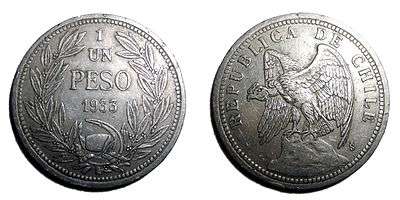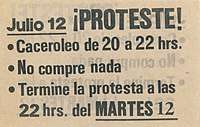Crisis of 1982
The Crisis of 1982 was a major economic crisis suffered in Chile during the military dictatorship after years of radical neoliberal reforms. It was the worst economic crisis in Chile since the 1930s Great Depression.[1] Chile's GDP fell 14.3%, and unemployment rose to 23.7%.[1]
| Economic history of Chile |
|---|
 |
|
Colonial era
|
|
Early republic |
|
Internal growth
|
|
Return of liberalism |
Background
After the socialist reorientation of the economy during the presidency of Salvador Allende (1970–1973) and its subsequent economic crisis which reached its zenith during 1973,[2] the Armed Forces following the orders of the Congress and with the support of the United States government made a Coup d'état and demobilized the Marxist Guerrillas loyal to Allende like the Revolutionary Left Movement. In 1975, after two years of heavy protectionism and statism, the military junta decided to reform the failing economy, and the Chicago boys were permitted to implement some of the neoliberal economical policies outlined in El ladrillo.[3] In 1979 however, Chile decided to depart from the principle of free floating exchange rates, with disastrous results.[4]
Boom and burst
The 1982 crisis has been traced to the overvalued Chilean peso, which had been helped by being pegged to the US dollar, and to the high interest rates in Chile, which would have hampered investment in productive activities. In fact, from 1979 to 1982, much of the spending in Chile was the consumption of goods and services.[3] By 1982, Chile's external debt had risen to over 17 billion dollars.[3]
In agriculture, the entrance of speculative capital before the crisis led to the bankruptcy of several processing companies.[5] IANSA, a sugar company that had belonged to the state before its privatization, went bankrupt because of a short-term gains policy by its new owners.[5]
Bank interventions
In November 1981, banks were bailed out by the government after they had taken excessive risks: the large Banco de Talca and Banco Español Chile and the small Banco de Linares and Banco de Fomento de Valparaíso.[6] Financial societies (Compañía General, Cash, Capitales and del Sur) were also bailed out.[6] Banco de Talca and Banco Español Chile were nationalized, removing the management and wresting ownership from shareholders (they were later privatized again).[7]
On January 13, 1983, the government made a massive bank intervention, bailing out five banks and dissolving three others.[6]
Agriculture contraction
All sectors of Chilean agriculture except fruit exports and forestry contracted during the crisis, but recovery was fast after 1984.[8] The number of farm bankruptcies in Chile increased from 1979 to its 1983 peak.[8]
Aftermath

The crisis has been credited of beginning, despite its severe repression, a wave of protest all over Chile against the dictatorship.[3]
In the years after the crisis, the economic policy of the dictatorship changed to include price bands for some foodstuffs and a floating exchange rate.[9]
Academic debate
Supporters of the neoliberal policy of the military dictatorship have argued that the crisis started outside Chile and hit the whole of Latin America in the so-called La Década Perdida (The Lost Decade).[3] Historians Gabriel Salazar and Julio Pinto have countered that the type of crisis is a frequently inherent weakness of the neoliberal model.[3] In contrast, economist Milton Friedman blames precisely the country's departure from the neoliberal model and political interventions in matters such as the Chilean peso.[10]
According to Ricardo Ffrench-Davis, the "unnecessary" radicalism of the shock therapy in the 1970s caused mass unemployment, loss of purchasing power, extreme inequalities in the distribution of income, and severe socioeconomic damage.[11] He argues that the 1982 crises as well as the "success" of the pragmatic economic policy after 1982 proves that the radical economic policy of the Chicago boys harmed the Chilean economy from 1973 to 1981.[12]
References
- (in Spanish) La transformación económica de chilena entre 1973-2003. Memoria Chilena.
- Historia contemporánea de Chile III. La economía: mercados empresarios y trabajadores. 2002. Gabriel Salazar and Julio Pinto. pp. 35–45.
- Historia contemporánea de Chile III. La economía: mercados empresarios y trabajadores. 2002. Gabriel Salazar and Julio Pinto. pp. 49–-62.
- "The Political Economy of Unilateral Trade Liberalization" (PDF). UCLA. 1990. Retrieved 2010-12-06.
- Rytkönen, P. 2004. Fruits of Capitalism: Modernization of Chilean Agriculture, 1950-2000. Lund Studies in Economic History, 31, pp. 34–35.
- A 25 años de la intervención bancaria en Chile. Economia y negocios. El Mercurio. January 12, 2008. Retrieved on May 15, 2012.
- What We Can Learn From Chile's Financial Crisis. Wall Street Journal. September 29, 2008. Retrieved May 14, 2012.
- Rytkönen, P. 2004. Fruits of Capitalism: Modernization of Chilean Agriculture, 1950-2000. Lund Studies in Economic History, 31, p. 26.
- Rytkönen, P. 2004. Fruits of Capitalism: Modernization of Chilean Agriculture, 1950-2000. Lund Studies in Economic History, 31, p. 66.
- Friedman, Milton; Friedman, Rose D. (1998). "Two Lucky People". University of Chicago Press. ISBN 9780226264158. Retrieved 2011-04-08.
- Konrad Adenauer Foundation, Helmut Wittelsbürger, Albrecht von Hoff, Chiles Way to the Social Market Economy
- Helmut Wittelsbürger, Albrecht von Hoff: Chiles Weg zur Sozialen Marktwirtschaft. (PDF; 118 kB); Konrad-Adenauer-Stiftung -Auslandsinfo. 1/2004, pp. 97, 104.